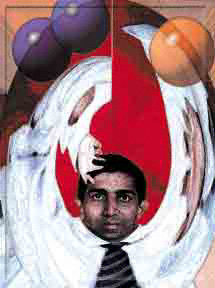- Home
- Archive -Feb 1999
- Mining the mind

Mining the mind
- In :
- Others
By Rupali Patil
February 1999
A unique combination of hypnosis and meditation promises to heal your body and help achieve goals by tapping the subconscious
Sleepless nights. Stress, tension and fatigue bog you down. You take a course of antibiotics and shrug it off. But is it really as simple as that? ‘Antibiotics and medicines make you feel relieved. But that’s temporary,’ says Sanjoy Mukerji, hypnotherapist, psychoanalyst, counselor and director of the Mind Control Institute, based in the western Indian city of Mumbai. ‘These problems tend to strike back.’ So what’s the solution? Going by the verdict of this clean-shaven, bright-eyed hypnotist, it is a simple, eight-syllable word: hypnomeditation.
But what is hypnomeditation? An impressive term for old wine in a new bottle? Or a novel therapy? Actually both. As the name suggests, hypnomeditation is a combination of two age-old disciplines—hypnosis and meditation. ‘The secret of hypnomeditation,’ says Mukerji, ‘lies in focused concentration excluding all external interference.’ And the subconscious mind is the ground for action.
Hypnosis, also known as vasheekaran vidya or sammohan vidya in India, is an ancient discipline. The term is derived from the Greek word ‘hypnos’, which means a sleep-like state. The 19th century French neurologist Jean Martin Charcot’s hypnosis experiments on hysterical patients actually gave psychoanalyst Sigmund Freud his first glimpse into the unconscious and the power of the libido.
The ABC of Human Mind, a Reader’s Digest publication, asserts that ‘hypnosis can control bad habits such as alcohol intake and overeating. Its deep relaxation techniques are useful in relieving stress and anxiety’. But being a pro is not easy. ‘Even though I had learnt hypnosis,’ says Mukerji, ‘it was only after years of practice that I mastered self-hypnosis.’
This unique therapy of mind control has many supporters. Roshan Office-wala, a 52-year-old housewife from the capital of the western Indian state of Maharashtra, Mumbai,, was addicted to sleeping tablets. ‘Unless I consumed one every night,’ she says, ‘I could not sleep. Hypnomeditation helped me control my mind and, consequently, my addiction.’
The idea in hypnomeditation is to enter a state of meditation through mild self-hypnosis and, in that state, repeat a few affirmations to tackle the problem at hand. Freudian theory states that many diseases are actually emotional in nature: deep seated impressions and traumas repressed in the subconscious manifest themselves in the form of ailments. Meditation helps release these traumas. It helps us penetrate into the unconscious world, unearth the hidden power and connect with universal consciousness.
 |
‘On its own, the meditation process is strenuous,’ says Mukerji. ‘Which is why it is best to combine meditation with hypnosis. Hypnomeditation zeroes in on the problem, examines its causes, finds a solution and then eliminates the problem.’ As in the case of Nasrullah Khan, a 30-year-old computer programmer, who had a volatile temper and was on the verge of committing suicide. ‘Hypnomeditation saved me,’ he confesses. ‘I feel a change within myself. I want to live now. Most importantly, I can control my anger.’
Hypnomeditation is also used to relieve pain. During trance, the brain emits a painkiller called dynorphin. Shell, Mukerji’s wife, affirms: ‘My mother had a severe cardiac problem and was admitted to the ICU. Doctors had almost given up. But she practiced hypnomeditation and left the hospital without undergoing any operation at all.’
Hypnomeditation takes the user from the conscious state of mind to the theta state or the No Thought State. The average brain vibrations, or beta waves, when we are awake, are about 20 cycles per second. Alpha waves are between seven and 14 cycles. Theta waves lie between 4 and 5 cycles and delta waves below 4 cycles per second. The beta state is the conscious and the alpha and the theta states are the subconscious level. And the more you practice hypnomeditation, the lower the frequencies that can be achieved.
‘Hypnomeditation is a way of using your body energy to treat yourself. That is why we use the ‘dhyan mudra‘ ( the meditating posture ) while hypnomeditating. It helps you get in touch with your self,’ explains Mukherji. ‘We also prescribe a mantra, the word ‘AM’, which gives you a sense of direction.’ In fact, Mukerji claims the vibrations created are so strong that after a few repetitions your body starts vibrating and you hear the mantra ( the ritualistic word ) echoing within.
So what is the core of the hypnomeditation system? Going by Mukerji’s words, it’s energy: there is energy everywhere and that energy is intelligent. ‘All this energy,’ he states, ‘is meant for our good. If you are in touch with this energy, you are in touch with the universal power.’ And forget those myths about sneaky crooks controlling your mind through hypnosis. ‘You can never be hypnotized if you don’t want to,’ affirms the hypnomeditation expert.
To read more such articles on personal growth, inspirations and positivity, subscribe to our digital magazine at subscribe here
Life Positive follows a stringent review publishing mechanism. Every review received undergoes -
- 1. A mobile number and email ID verification check
- 2. Analysis by our seeker happiness team to double check for authenticity
- 3. Cross-checking, if required, by speaking to the seeker posting the review
Only after we're satisfied about the authenticity of a review is it allowed to go live on our website
Our award winning customer care team is available from 9 a.m to 9 p.m everyday
The Life Positive seal of trust implies:-
-
Standards guarantee:
All our healers and therapists undergo training and/or certification from authorized bodies before becoming professionals. They have a minimum professional experience of one year
-
Genuineness guarantee:
All our healers and therapists are genuinely passionate about doing service. They do their very best to help seekers (patients) live better lives.
-
Payment security:
All payments made to our healers are secure up to the point wherein if any session is paid for, it will be honoured dutifully and delivered promptly
-
Anonymity guarantee:
Every seekers (patients) details will always remain 100% confidential and will never be disclosed
